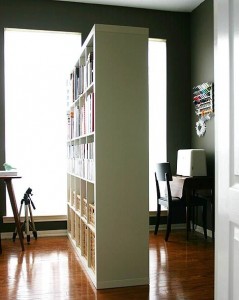Part 3 of a 3 part mini-series.
I saved the most challenging for last: how to set up a productive and comfortable home office when your only option is a space that is actively used for other functions, such as your family room or living room, as opposed to an un-used formal living room or dining room.
The keyword for your home office is “boundaries”: time boundaries, physical boundaries, visual and auditory boundaries.
If your shared space has a niche or alcove, it can be set-up as either your home office or the television viewing area. Moving your TV to a smaller area is one way to de-emphasize television viewing as a default activity.
If you work at home during the day and you and your family are active in your gathering room in the evening, then use time boundaries. The space is yours during the daytime and for the family in the evening. If your children are older, then quiet reading or homework while you work can be parallel after-school activities in the shared space.
The biggest bugaboo is the television. Sarah Susanka, author of the Not So Big House writes:
“The most common difficulty is that when the TV is in the primary socializing spot, … the TV tends to monopolize everyone’s attention, making it impossible to do anything but watch.”
If you can work out television viewing times with your family – that allow you to work – then you are in luck. If your lifestyle or the ages of your children preclude this then you need to create visual and auditory boundaries for you and your workspace.
One solution is to arrange one or two bookcases at right-angles to the wall, thus creating an alcove for your workspace. This will give you visual privacy from the other activities in the room. Position the bookcases so that the books face either your workspace, the rest of the room of if you are using more than one bookcase, a bit of both. For the greatest privacy use a bookcase with a solid back. Decorate the blank back of the book case with paint, jazzy wallpaper, posters or framed prints. Or you can use a folding screen or hang a curtain to partition off an area. When the screen is up or the curtain is closed that is the signal to your family that you are working and not to be disturbed.
Auditory privacy can be a bit tricky. Headphones connected to your computer or MP3 player while listening to your favorite “working music” can mask (but not block-out) household noise. (You can read more about what kind of music best supports your kind of work activity here. ) Or a small fan can create enough white noise to mask background distractions. If you need total silence then check out noise-canceling headphones.
An area rug in your home office space is another way to define your territory
An office armoire or closet workspace is the last choice. The small enclosed space is a symbol of limited growth for your career or business. If you are just paying bills online, surfing the web or visiting with friends on Facebook, then a closet or armoire home office is fine.
What solutions have you devised to solve the problem of limited/no space for your home office. Please share your solutions and questions in Comments below.
To learn more, read the “Dinosaur Space” chapter of my book The Smarter Home Office
photo by The Haystack Needle

Nice piece. I like the photo. Judy